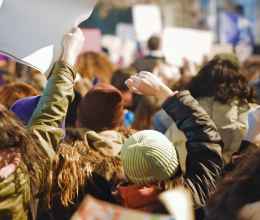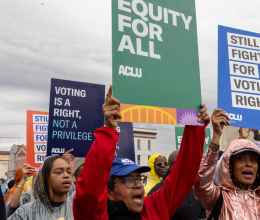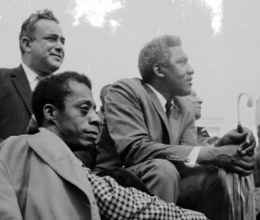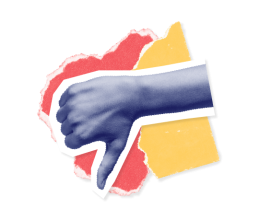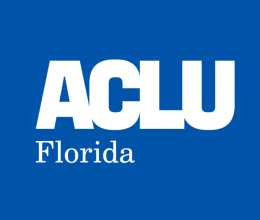
On election night, Americans across the country were focused on one number: 270.
It’s a well-known – and hotly-contentious – fact that in American politics, presidential candidates must win 270 Electoral College votes to secure the White House. While news media rushed to declare the candidate with the most Electoral College votes on or around Election Day, the Electoral College’s work does not begin, nor end, on Election Day. Instead, electors cast their official votes on the first Monday after the second Wednesday in December following the presidential election, which this election cycle falls on December 17.
At the ACLU, we have long argued that the Electoral College is an antiquated and undemocratic process for choosing the highest elected offices in our nation. So why do we have the Electoral College? What does it really do and do we actually need it? The ACLU explains.
The Electoral College was Created as a Compromise
Though the term "Electoral College" doesn't appear in the Constitution, it was established during the Constitutional Convention of 1787 to address disagreements over how to select the president and vice president. The original system, outlined in Article II of the Constitution, allowed each elector to cast two votes for president, with the candidate who received the most votes becoming president and the second place finisher becoming vice president. This led to complications when political rivals were elected to these roles, prompting the adoption of the 12th Amendment in 1804, which required electors to cast separate votes for each office.
At the time, regional divisions also influenced the College’s creation. Southern states, where non-voting enslaved people made up about one-third of the population, opposed a direct popular vote that would have given their states less votes. After much debate, the convention eventually reached the decision to establish the system we now refer to as the Electoral College, applying the three-fifths compromise that counted three out of five enslaved people as part of a state’s total population, though they were still prohibited from voting.
State Size Determines The Number of Electoral Votes a State Gets
The number of Electoral College votes allocated to each state is equal to its total representation in Congress: two votes for its Senators and a number corresponding to its members in the House of Representatives. This allocation is based on the Census, which determines congressional apportionment every 10 years. In total, the Electoral College consists of 538 members, including three votes for the District of Columbia, granted by the 23rd Amendment ratified in 1961. A simple majority of electoral votes (270 or more) is required to elect the president and vice president.
State Electors Aren’t Actually Elected
The process for selecting electors varies by state, but typically involves a two-step process. Political parties first nominate a slate of electors who pledge to support their party’s candidate before the general election, often selecting party loyalists, state officials, or individuals with ties to their candidate. On Election Day, voters choose their state’s electors indirectly by voting for their preferred presidential candidate. Most states follow a winner-take-all system in which the candidate with the most votes receives all of the electoral votes in the state. Maine and Nebraska use a proportional allocation system, assigning two “at-large” electors to the overall statewide winner and appointing individual electors based on the winner of the popular vote within each Congressional district.
Electors Who Stray From the Popular Vote Could Face Fines
Electors are not bound by the Constitution to vote according to the states’ popular vote, but more than 30 states and Washington D.C. have laws that legally obligate them to do so. Some states, such as South Carolina and Oklahoma, even impose criminal action or fines against electors that stray from the states’ popular vote.
Electors Don’t Vote On Election Day
Electors don't actually vote until December – more than a month after the election. During their meeting, electors formally cast separate votes for president and vice president with their results recorded on Certificates of Vote that are sent to the vice president acting as president of the Senate, relevant state officials, the local federal district courts, and the National Archives. These certificates must reach Washington, D.C. by December 25 to be included in the official count.
The final count, however, doesn't occur until even later. This year, on January 6, during a joint session of Congress, officials will declare the president and vice president. The president-elect takes the oath of office and is sworn in two weeks later. If no candidate receives a majority of at least 270 votes, the election is decided by Congress, with the House selecting the president and the Senate choosing the vice president.
Why America Doesn’t Use the Popular Vote
The ACLU has opposed the Electoral College since 1969 for non-partisan reasons, including its undemocratic and unpredictable nature. Unfortunately, amending the Constitution to eliminate this antiquated system is difficult not just because amending the Constitution is hard – it would require at least 37 states to agree to a proposed change – but because the College’s supporters believe that it is a way to give small states power. States receive electoral votes equal to its congressional delegation, guaranteeing a minimum of three votes regardless of population size. This system elevates the influence of smaller states, as larger states would otherwise dominate national elections.
Why We Should Work to Eliminate the Electoral College
The Electoral College thwarts the fundamental principle of “one person, one vote” by awarding each state a number of electoral votes equal to its allocation of representatives plus its two senators. A voter in Wyoming thus has more than three times as much influence on the presidential election as a voter in more densely-populated California. That’s not to mention the racial and ethnic disparities in voting power that influence how electoral votes are allocated. One study calculated that Asian-Americans have barely more than half the voting power of white Americans because they tend to live in “safe” states — like Democratic-leaning New York and California and Republican-leaning Texas.
Right now, the Electoral College harms democracy when it:
- Nullifies the popular vote. In five presidential elections, the winner of the electoral college has lost the popular vote. This means that a presidential candidate that did not achieve a majority of the votes and was not supported by a majority or even plurality of the American people can still win through the electoral college and thus the election. Critics argue that the nullification of the popular vote also has a negative effect on voter turnout, discouraging voters from feeling like voting matters.
- Shrouds Electors in Secrecy. In most states, there is very little public information about how electors are selected and who they are. The process is entirely determined by political parties and incorporates little voter input. Many states also do not have laws requiring electors to vote according to the popular vote in their state, risking the possibility of “faithless” electors who may vote contrary to the will of the voters.
- Gives “swing states” an unfair advantage. The Electoral College system disproportionately benefits certain “swing states” in which the outcome of the election is uncertain. Presidential candidates from both political parties often invest significant resources and attention in these states, neglecting voters in states with a more predictable political leaning.
The Electoral College undermines the principle of “one person, one vote” by giving disproportionate influence to smaller states and swing states allowing a candidate to potentially win the presidency without securing the popular vote. This outdated system fails to reflect the will of the people in a modern democracy, creating inequities in representation. Despite the uphill battle, amending the Constitution to abolish the Electoral College would ensure that every vote carries equal weight in presidential elections.
